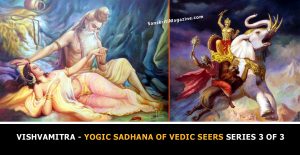
Vishvamitra – Yogic Sadhana of Vedic Seers Series 3 of 3
~ By Mukesh Bhatnagar (Exclusive for Sanskriti Magazine) As has already been indicated, if Vishvamitra’s yogic sadhana starts with meditation on Agni as the universal

~ By Mukesh Bhatnagar (Exclusive for Sanskriti Magazine) As has already been indicated, if Vishvamitra’s yogic sadhana starts with meditation on Agni as the universal

Squeezing of Soma as symbolic of Yogic sadhana ~ By Mukesh Bhatnagar (Exclusive for Sanskriti Magazine) In the Vedic sadhana, all sorts of crude experiences received

~ By Mukesh Bhatnagar (Exclusive for Sanskriti Magazine) A house of thousand doors cannot but be the state of emancipation. This interpretation has its plausibility

Creative and dynamism is the nature of Consciousness ~ by Yogi Mukesh (Exclusive for Sanskriti Magazine) Besides being luminous, consciousness is also creative and on account

~ By Mukesh Bhatnagar (Exclusive for Sanskriti Magazine) Vishvamitra’s realization of his real identity in the omniscient Agni speaks of his elevation to pure consciousness

Luminosity is the nature of consciousness ~ by Yogi Mukesh (Exclusive for Sanskriti Magazine) Luminosity is another feature of consciousness which is rarely taken note of

Chhath Puja is one of the most revered festivals, especially in Bihar, Jharkhand, and Uttar

As the festival of lights approaches, the excitement for Diwali grows. Celebrated across India and

Learn about the significance and rituals of Navratri Day 9, dedicated to Goddess Siddhidatri, who grants all supernatural powers. Discover her mantra, spiritual significance, and how to worship her for fulfillment.

Discover the significance of Navratri Day 8 as we honor Goddess Mahagauri, the symbol of purity and serenity. Learn about the rituals, mantra, and offerings for this special day of Navratri 2024.

Explore the significance and rituals of Navratri Day 7 dedicated to Goddess Kalaratri, the fierce form of Durga. Discover her connection to the Sahasrara Chakra, her mantra, offerings, and more.

Sanskriti comes from the Sanskrit root “kr” which means to do or to make prefix “sam” is applied before it to convey a sense of embellishment. It means actions done for the holistic refinement and perfection all the potentialities within a human being.
“The term “Rishi” in Sanskrit originates from a root that means “To See.” Rishis, quite literally, “see” truths that are unveiled to them in elevated states of consciousness. .These are recorded in Sacred texts called Upanishads , Vedas etc. The wisdom imparted by ancient Rishis has not only enriched the realm of inner science but has also played a pivotal role in shaping and advancing modern scientific understanding. Let us Explore……
Copyright © 2024. Sanskriti Magazine
Copyright © 2024. All rights reserved.